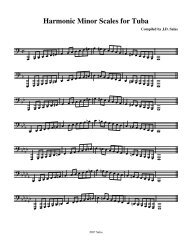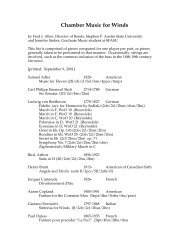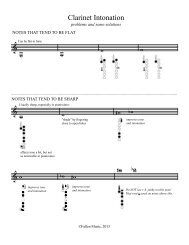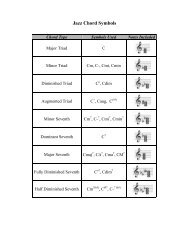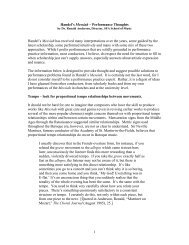Trombone Rep - History of the Trombone - Timeline 1 (EatonMensch ...
Trombone Rep - History of the Trombone - Timeline 1 (EatonMensch ...
Trombone Rep - History of the Trombone - Timeline 1 (EatonMensch ...
Create successful ePaper yourself
Turn your PDF publications into a flip-book with our unique Google optimized e-Paper software.
<strong>History</strong> <strong>of</strong> <strong>the</strong> <strong>Trombone</strong><br />
P. 17<br />
Date Information Citation<br />
1780-1790s<br />
A.D.<br />
1780s-1790s<br />
A.D.<br />
1780s-1790s<br />
A.D.<br />
1784 A.D.<br />
1787 A.D.<br />
"Mozart used trombones in three operas: Idomeneo (K. 366, 1781), Don Giovanni (K. 527,<br />
1787), and Die Zauberflote (K. 620, 1791). Significantly <strong>the</strong>se are his only operas with<br />
strong supernatural or religious elements, and <strong>the</strong> trombones have no o<strong>the</strong>r function but to<br />
support those elements."<br />
<strong>Trombone</strong> parts written in French Military music are generally simplifications <strong>of</strong> o<strong>the</strong>r parts.<br />
The most commonly used trombone for this music is <strong>the</strong> bass trombone. When used, <strong>the</strong> Alto<br />
and Tenor trombones provide "harmonic filler."<br />
"The basson was <strong>the</strong> primary bass instrument" in <strong>the</strong> military band, followed by <strong>the</strong> serpent<br />
and bass trombone.<br />
<strong>Trombone</strong>s had not been used in England in such a long period <strong>of</strong> time that it was difficult to<br />
find experienced players for <strong>the</strong> "Handel Celebrations."<br />
Haydn marks his trombone parts in The Seven Last Words with a wide range <strong>of</strong> dynamics<br />
and, rare for its time, articulations: "Nearly every movement includes slurs and staccato."<br />
Guion p. 240<br />
Guion p. 289-294<br />
Guion p. 289<br />
Bate p. 146<br />
Guion p. 222<br />
1787 A.D.<br />
Antonio Salieri uses trombones in more scenes than any o<strong>the</strong>r opera <strong>of</strong> <strong>the</strong> time in Tarare .<br />
He does not always use <strong>the</strong> trombones to signify <strong>the</strong> super natural, but "<strong>the</strong> smell <strong>of</strong> gloom<br />
and death hangs heavily over each scene" in which <strong>the</strong> tromboes play.<br />
Guion p. 244, 246<br />
1787 A.D. Carse shows three trombones in <strong>the</strong> royal orchestra <strong>of</strong> Berlin in 1787.<br />
The Opera [(Paris)], <strong>the</strong> Concert Spirituel, and <strong>the</strong> Theatre de la rue Feydeau hire <strong>the</strong> first full-<br />
Guion P. 267<br />
1789 A.D. time trombonists in French ensembles. After this point <strong>the</strong> trombone becomes a regular<br />
member <strong>of</strong> concert and operatic orchestras.<br />
Guion p. 177<br />
1789-1799<br />
A.D. and<br />
following<br />
1789-1815<br />
A.D.<br />
During and after <strong>the</strong> French Revolution, trombones are used less in opera and <strong>the</strong>ater music.<br />
One trombone part becomes more common - it is usally a bass trombone part (played on Bb<br />
tenor).<br />
Philippe Widerkehr was a faculty member <strong>of</strong> <strong>the</strong> Paris Conservatory and probably played and<br />
taught trombone.<br />
Guion p. 252-3<br />
Guion p. 190



![Finale 2008 - [Whole Tone Scales - Tuba.MUS]](https://img.yumpu.com/50937649/1/190x245/finale-2008-whole-tone-scales-tubamus.jpg?quality=85)

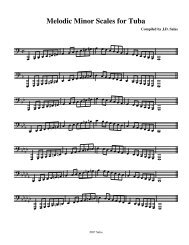
![Finale 2008 - [Chromatic Scales - Tuba.MUS]](https://img.yumpu.com/36500491/1/190x245/finale-2008-chromatic-scales-tubamus.jpg?quality=85)
